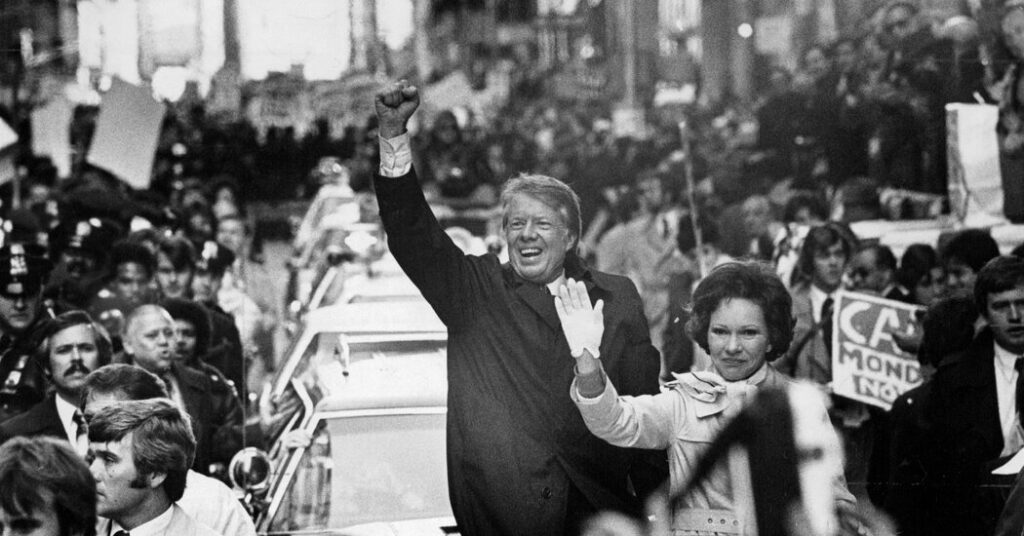In the wide range of articles published by The New York Times this week after the death of former President Jimmy Carter, a fragment of largely forgotten Canadian history resurfaced.
The Times’s visual story of his life, told through a variety of objects, reveals how Mr. Carter came to assist in the cleanup of a major nuclear accident near Ottawa in 1952.
[Read: Jimmy Carter’s Life, in 17 Objects]
Among the 17 objects, photographed by Tony Cenicola and described by Bill Marsh, is a yellowed certificate issued in 1953 by the Knolls Atomic Power Laboratory in New York State, proclaiming Mr. Carter an “atomic submariner.”
He was a naval officer at the time he received it. Mr. Carter had attended the U.S. Naval Academy from 1943 to 1946, on his way to becoming the first in his family to graduate from college, and served in the submarine fleet during World War II. Later, he was involved in the development of the nation’s first nuclear-powered submarines; the Knolls certificate was for completing his training.
But before that, Mr. Carter got a firsthand look at the immense power of nuclear energy in Canada.
On Dec. 12, 1952, a series of missteps and a mechanical failure led to the partial meltdown of the core of the NRX reactor at the Chalk River Laboratories on the Ottawa River, about 180 kilometers northwest of the capital. The incident gave Canada the dubious distinction of hosting the world’s first nuclear reactor accident.
The NRX had a capacity of 30 megawatts that day, which was powerful by the standards of its time (today the Bruce Power nuclear plant in Ontario churns out 6,400 megawatts).
On the day of the accident, the reactor was powered down for an inspection of its cooling system. In the basement, a worker mistakenly raised a few of the control rods that can reduce and, if necessary, completely shut down the chain reaction in the reactor.
That was spotted quickly, and a supervisor thought, based on some signal lights, that he had lowered the rods back in place. But the lights were wrong: Two or three of the rods were stuck and had only partly returned to safety.
When the supervisor, who was still in the basement, phoned the control room with directions for lowering the rods, he also mixed up the numbers for the buttons that needed to be pushed, compounding the problem.
The reactor’s output soared to about 100 megawatts.
That power surge lasted for only one minute and eight seconds before the reactor was brought back under control, but the damage was profound. Fuel rods had melted or blown apart. The basement was filled with one million gallons of highly radioactive water and debris. The reactor building, which had large glass windows, was dangerously radioactive.
A contingent of 150 members of the U.S. military came to Chalk River for the cleanup. Among them was Mr. Carter, who led a group of about 12 members of the Navy from the Knolls Laboratory. They were joined by 862 workers at the Chalk River site, 170 members of the Canadian Army and 20 employees of companies that had made parts of the reactor.
Morgan Brown, president of the Society for the Preservation of Canada’s Nuclear Heritage, which runs a museum near Chalk River, told me that the Americans hadn’t been there to give technical advice, as the NRX had been designed in Montreal in a joint Canadian-British project. But they provided equipment Canada lacked, like closed-circuit television, and they gained experience and training for themselves in dealing with the unprecedented situation.
“The American help was well appreciated,” said Mr. Brown, who worked for decades at NRX’s owner, Atomic Energy of Canada, studying ways to prevent reactor disasters.
A progress report made a few months after the Chalk River accident shows that Lieutenant Carter, then 28, and his group worked on a “header” that fed cooling water from the river into the reactor, Mr. Brown said.
In interviews, Mr. Carter recalled that his team had used a mock-up of the reactor to practice dismantling techniques in advance and had worked in shifts to limit exposure to radiation. A 1959 film produced by the American and Canadian governments shows those trial runs — and suggests that the standards for worker safety and radioactive waste disposal were well below current practices.
The NRX reactor kept operating until 1992. The Chalk River accident remains the worst in Canadian history.
The worst nuclear energy accident in U.S. history, the partial meltdown of a reactor at Three Mile Island in Pennsylvania in 1979, would happen during Mr. Carter’s presidency. Days after the accident, he and his wife, Rosalynn Carter, toured the plant and told residents, “If we make an error, all of us want to err on the side of extra precautions and extra safety.”
(If you haven’t read it, I recommend the sweeping and authoritative obituary of Mr. Carter by Peter Baker and Roy Reed.)
Trans Canada
Ian Austen reports on Canada for The Times and is based in Ottawa. Originally from Windsor, Ontario, he covers politics, culture and the people of Canada and has reported on the country for two decades
How are we doing?
We’re eager to have your thoughts about this newsletter and events in Canada in general. Please send them to nytcanada@nytimes.com.
Like this email?
Forward it to your friends, and let them know they can sign up here.


